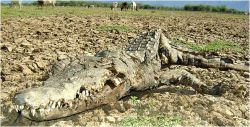Tuesday, April 16, 2024
News and Views from the Global South
KENYA: Key Lakes Succumb to Human Activities
- Several years ago, Lakes Kamnarok and Ol Bollosat in Kenya were vibrant water bodies that supported and shaped the ecosystems around them. But today they are shells of their former selves, due to heavy siltation caused by human activities.

A crocodile carcass on Lake Kamnarok. In the distance cows graze on the lake bed. Credit: Peter Kahare
“Siltation is still happening, the lake is drying up and this is threatening Lake Kamnarok and the wildlife with extinction, besides affecting the lives of people around it,” Elijah Chemitei, senior warden in Baringo County, in the Rift Valley Province, told IPS. “Much of it is caused by upstream activities like tree-felling and charcoal-burning, agricultural activities, grazing and sand collection.”
Lake Kamnarok, in the arid county of Baringo, is the only oxbow lake (a crescent-shaped lake that is formed when a meander of a river is cut off from the main channel) in the country. It used to have the second-largest population of crocodiles in Africa, after Lake Chad.
“The crocodiles at the lake used to be over 30,000 in population; they are now less than 5,000 after many died while others prefer to inhabit the Kerio River that formed the lake. Wild animals at the Rimoi Game Reserve next to the lake are endangered and tourism in general is in jeopardy,” says Chemitai. Roy Kiplagat, a resident in Baringo County, says the displacement of the crocodiles has meant that domestic animals are now in danger of becoming prey.
“This is happening at Kerio Valley through which the Kerio River passes. Crocodiles that have moved out of the river have killed many goats as they drink water,” he says.
Chemitei says that Lake Kamnarok has become increasingly shallow, decreasing in size from 10 square kilometres to two square kilometres. He says people are felling trees, burning charcoal and farming in the nearby indigenous forests. So when it rains the soil is washed down into the lake.
The lake was once a water source for over 500 elephants and over 10 species of other mammals from the adjacent Rimoi Game Reserve. Other animals found around the lake are impalas, bushbucks, warthogs, leopards, buffaloes and an endangered mammal called funkleen.
However, Chemitai says that the number of tourists visiting Rimoi has reduced over the years because of the decreasing numbers of wild animals. And those wild animals that remain have retreated as cows have taken over the area for grazing.
Poaching is another challenge here.
“Poachers enter into the reserve to hunt. Last year we lost many animals to poachers and we are disadvantaged because we lack enough game rangers,” says Chemitai.
Chemitai said the County Council of Baringo, the local authority mandated to control human settlement, was partly to blame as it was reluctant to prevent people from intruding onto the riparian land.
“We are asking people who have encroached into the lake to move out. The County Council of Baringo has failed to control settlement and prevent illegal occupation in the riparian land,” Chemitai told IPS.
Albert Lagat, an environmental conservationist and the head of Esageri Sabatia Environmental Organization, an NGO that plants trees in deforested catchments, says urgent action needs to be taken to save Lake Kamnarok.
He notes that the Ketipborok, Cheplogoi, Oiwo and Chelabei Rivers that flow into Lake Kamnarok have either dried up completely or become seasonal following the destruction of their sources.
“The lake had plenty of water sometime back. Urgent measures like reforesting the forests with indigenous trees, sensitising people to protect the lake and to move out of the land near the lake should be taken,” says Lagat.
He adds that Lake Ol Bollosat, the only lake in Central Province and one of the few highland lakes in the world, has also suffered a similar fate.
A group of 250 families affected by Kenya’s post-election violence, which saw about 600,000 people displaced from their homes after the country’s disputed 2007 elections, have bought land on the shore of the lake where they have now settled.
Their destruction of the nearby Aberdare Forest has caused the rivers that run from the forest into Lake Ol Bollosat to dry up.
Lake Ol Bollosat used to be home to a number of hippopotamuses and up to 200 species of birds, and is the source of water that feeds Thompsons Falls, Kenya’s most scenic waterfall. Standing at 2,360 metres above sea level, the 72-metre waterfall is an important tourist attraction and source of revenue in Nyahururu, one of Kenya’s highest towns.
“This lake has reduced in size from between 5,000 to 10,000 hectares to less than 3, 000 hectares currently in less than three years. Consequently hundreds if not thousands of birds have shifted to other lakes or died, hippos have continued to die with tourists opting to go to other places,” Lagat told IPS.
Lagat says that despite the government’s order over a year ago that people encroaching on Aberdare Forest be moved; nothing has been done. Last year, the Environmental Ministry introduced a policy that directed the cutting down of eucalyptus trees in wetlands and along riverbanks. The trees are blamed for their consumption of huge amounts of water.
“Some people have, however, continue to grow these trees to the detriment of rivers and important catchment areas,” Lagat says.
However, William Kimosop, a game warden at Baringo, says that the Kenya Wildlife Service is working hard to protect these resources and open up the region to tourism.

 Print
Print



